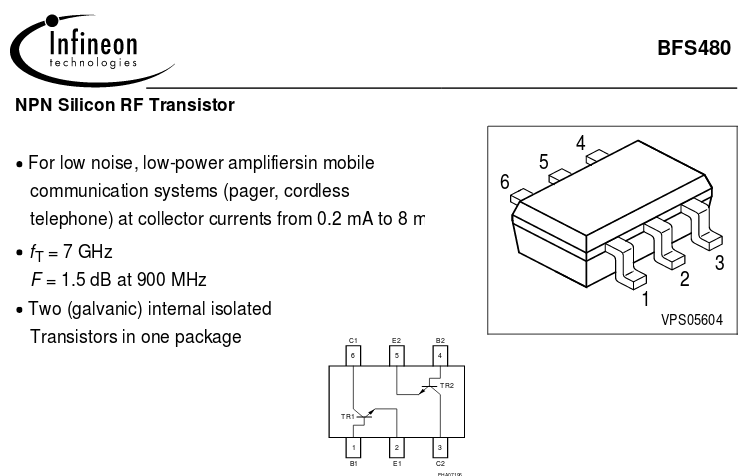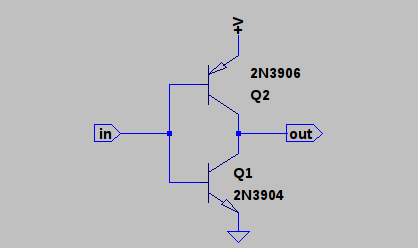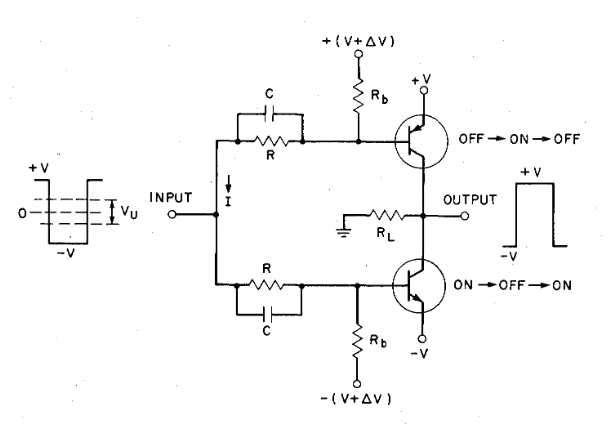-
Faster and smaller
03/26/2017 at 09:17 • 0 commentsIn the past months, I have been collecting ultra-fast bipolar transistors : BFR96, BF970, BFG425W, and an ample supply of MMBTH81.
Lately I found an even faster reference, even cheaper, even more integrated :
![]()
One of these SOT363 chips (like, SOT23 with 6 pins) can make a differential pair. 4 of them make a flip-flop.
The BFS480 and the MMBTH81 make great parts for a fast, compact, bipolar processor...
-
Low-Voltage, Complementary Bipolar Logic
01/10/2017 at 07:29 • 6 comments@Ted Yapo suggested a very unusual circuit in @esot.eric's thread
Soon enough, he tried the circuit and created #CBJT Logic !![]()
I found out that Baker (of diode clamp fame) had explored this kind of circuit:
And tonight, Ted tried some of the enhancements, which reduced the consumption and increased the speed !Speeding Up the NOT Gate![]()
The sweet spot seems to be between 1V and 1.1V with approximately 10ns of propagation time per inverter, and a not-too-high current draw...
I am very tempted to play with this kind of gates for this project but experience with the other technologies show that a critical gate is the MUX2 (and MUX4) which are not trivial to design with this method. I should investigate "pass gates" made of NPN and PNP transistors...
-
Inventory
01/06/2017 at 09:30 • 3 comments(20170326) (rev 20200524) The germanium inventory is there
So far, my silicon stocks are:
Reference Pol. Ft(Hz) U(V) I(mA) P(mW) hFE Fab Qty BC549C NPN 250M 30 100 625 400..800 CDIL 14500 BC550C NPN 250M 45 100 625 400..800 CDIL 2000 BC559C PNP 250M 30 100 625 400..800 CDIL 5000 MMBTH81 PNP 600M 20 50 60 Fairchild 9000 KSP10/
MPSH10NPN 650M 25 350 >60 Fairchild 1500 BF970 PNP 1G 30 30 Philips 200 BF1009SZ N-ch 1F 9 10 Infineon
/Siemens30 BFR96 NPN 3.2G 15 75 170 BFG425 NPN 3G? 4.5 30 135 NXP 200 BFS480 NPN 7G? 8 10 100
(30..200)Infineon
/Siemens4800
(+?)BFP420 NPN 25G 4V 60 200 60..130 Infineon
/Siemens100 (?) 2N2369A NPN 500 15 200 360 20..120 MOT(?) 50 PMBT2369 NPN 500 15 200 250 20..120 Philips 9000 Note: Ft (transition frequency) is often misleading:
- For the KSP10 it's given as the "Current Gain Bandwidth Product", the part is tested up to 100MHz only (with some plots up to 1GHz).
- The BFG425 is given as a "25GHz" part but the datasheet gives data tested up to 3GHz.
Why a PNP in the middle of the NPN ? Because of Complementary ECL : it must be possible to "pack" some gates together to form a circuit with alternating polarities, save some time and gates, and power too. For example the BFS480 could be paired with the MMBTH81 (though the speed disparity might not be a great choice)
I stumbled upon a stock of 2N2369, they might as well be included in this inventory "for scientific purposes". https://hackaday.io/project/8449-hackaday-ttlers/log/177581-my-own-try-at-a-ringo9-with-2n2369a uses some of them and I tested the 5ns rise time with few efforts (it can go faster with more efforts).
Note: some BC549C are already gone to contribute to #The Cardboard Computer :-)
20200521 : added the PMBT2369 and the BFP420
 Yann Guidon / YGDES
Yann Guidon / YGDES

